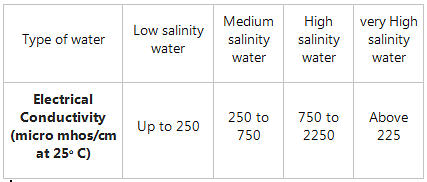Test: Irrigation Engineering- 1 - Civil Engineering (CE) MCQ
20 Questions MCQ Test Mock test series of SSC JE Civil Engineering 2025 - Test: Irrigation Engineering- 1
Wetted perimeter of a regime channel for discharge of 144 cumec as per Lacey’s theory will be:
If the electrical conductivity of water is in between 750 to 2250 micro mhos/cm at 25oC, then it is classified as:
| 1 Crore+ students have signed up on EduRev. Have you? Download the App |
A canal which is aligned at right angles to the contour is called
The discharge passing over an ogee spillway is given by _______, Where, L is an effective length of spillway crest and H is the total head over the spillway crest including velocity head.
The sodium carbonate lining in canal consist of at least
Critical velocity of flow (Vo) given by Kennedy is
Where, m = critical velocity ratio, D = Depth of water over the bed portion of a channel in meters
Which of the following are the main causes of water logging:
A field of 500 hectares is to be irrigated for a particular crop having 100 days base period. The total depth of water required by the crop is 100 cm. Calculate the duty of the water (in hectares per cubic metre).
For smooth entry, the regulators are aligned at an angle of “x” to the water. The value of “x” is:
The relation for discharge over a rectangular crest of a sarda fall is
Where, L = Length of crest in meters
B = top width of the crest in meters
H = depth of water in meters
The structure build at the head of the watercourse so as to connect it with a minor or a distributor channel is known as:
If D is the depth of scour below original bed, then the width of launching apron is generally taken as:
Which one of the following is the purpose of providing the downstream sheet pile in a barrage?
Which of the following spillway gates cannot be seen from a distance, when lowered?
|
1 videos|1 docs|64 tests
|
|
1 videos|1 docs|64 tests
|





















